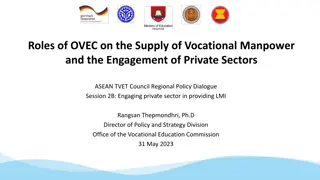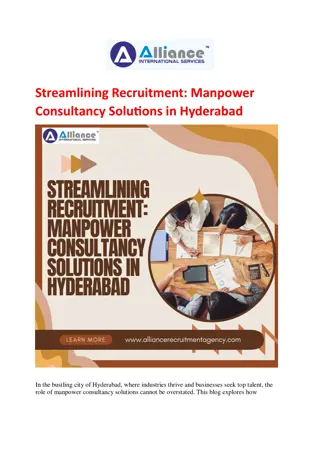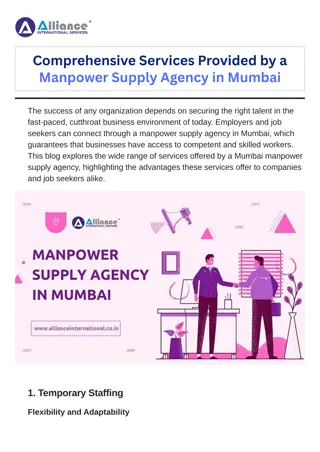
Strategic Manpower Planning: Importance, Objectives, and Strategies
Learn about the significance of strategic manpower planning in aligning human resources with business goals, optimizing resource utilization, talent acquisition and retention, adaptability, agility, succession planning, and leadership development. Explore the objectives of forecasting future workforce needs, optimizing workforce utilization, and ensuring talent availability for organizational success.
Download Presentation

Please find below an Image/Link to download the presentation.
The content on the website is provided AS IS for your information and personal use only. It may not be sold, licensed, or shared on other websites without obtaining consent from the author. If you encounter any issues during the download, it is possible that the publisher has removed the file from their server.
You are allowed to download the files provided on this website for personal or commercial use, subject to the condition that they are used lawfully. All files are the property of their respective owners.
The content on the website is provided AS IS for your information and personal use only. It may not be sold, licensed, or shared on other websites without obtaining consent from the author.
E N D
Presentation Transcript
Manpower Planning: Meaning Manpower planning, also known as human resource planning, is the process of forecasting an organization's future human resource needs and ensuring that it has the right number of employees with the right skills in the right positions at the right time. It involves analyzing the organization's current workforce, identifying future staffing requirements, and developing strategies to address any gaps between organizations anticipate and proactively address future workforce challenges and enhancing their competitive advantage and long-term sustainability. the two. It helps opportunities, thereby
Importance of Manpower Planning 1. Strategic Alignment: Within the framework of manpower planning, there is the correspondence of the number of employees with the company's strategic direction and business goals. 2. Optimized Resource Utilization: Smart manpower planning is key in achieving quality resource deployment by employing the best qualified with the right skill at the designated time. This reduces the inefficiencies caused by overstaffing or understaffing, hence improving the productivity of staff and reducing expenditure on recruitment. 3. Talent Acquisition and Retention: Manpower planning serves as a driver of proactive talent acquisition, employee mentoring and other retention strategies.
Importance of Manpower Planning 4. Adaptability and Agility: Organizations of today should learn to be ready to change and keep ahead. Manpower planning will help businesses to foresee and react to market variations, technology upgrade, and the trends in the industry by having the best capability of workers so that the companies will be able to enjoy all the benefits. 5. Succession Planning and Leadership Development: It is the human resource management function, which is of high importance in succession planning and leadership development.
Objectives of Manpower Planning 1. Forecasting Future Workforce Needs: Manpower planning aims to forecast the organization's future staffing requirements based on factors such as business growth technological advancements, and changes in industry regulations. 2. Optimizing Workforce Utilization: Manpower planning seeks to optimize the utilization of the organization's workforce by ensuring that the right people with the right skills are in the right positions at the right time. 3. Ensuring Talent Availability: Manpower planning aims to ensure the availability of talent to meet current and future organizational needs. This includes identifying and attracting top talent, developing existing employees through training and development programs, and implementing succession planning initiatives to cultivate a pipeline of future leaders. projections, market trends,
Objectives of Manpower Planning 4. Supporting planning provides valuable insights and data to support strategic decision-making at all levels of the organization. By aligning human resource strategies with broader business objectives, manpower planners help organizations make informed decisions about workforce investments, resource allocation, and organizational structure. 5. Mitigating Risks and Uncertainties: Manpower planning helps organizations mitigate risks associated with workforce shortages, skills gaps, turnover, and other workforce-related challenges. Strategic Decision-Making: Manpower
Process of Manpower Planning 1. Establishing Objectives and Scope: The first step in manpower planning is to define the objectives and scope of the planning process. This involves clarifying the organization's strategic goals, identifying key workforce challenges and opportunities, and determining the timeframe and resources available for manpower planning activities. 2. Environmental Analysis: Manpower planning begins with an analysis of the external and internal factors that may impact the organization's workforce needs. 3. Demand Forecasting: The next step is to forecast the organization's future demand for human resources based on the analysis of environmental factors and business objectives. requirements by department, function, or skill set over a specified time period, taking into account factors such as business growth, expansion into new markets, and changes in technology. This involves projecting staffing
Process of Manpower Planning 4. Supply Analysis: Once the future demand for human resources has been determined, manpower planners conduct a comprehensive analysis of the organization's current workforce capabilities and availability. 5. Gap Analysis: Manpower planners compare the projected demand for human resources with the existing supply to identify any gaps or mismatches between the two. 6. Developing Strategies and Action Plans: Based on the findings of the demand forecast, supply analysis, and gap analysis, manpower planners develop strategic initiatives and action plans to address identified workforce challenges and opportunities. 7. Implementation and Monitoring: Manpower planners implement the strategies and action plans identified in the manpower plan and regularly monitor their progress and effectiveness. 8. Evaluation and Feedback: The final step in the manpower planning process is to evaluate the outcomes of the planning efforts and gather feedback from key stakeholders.






















